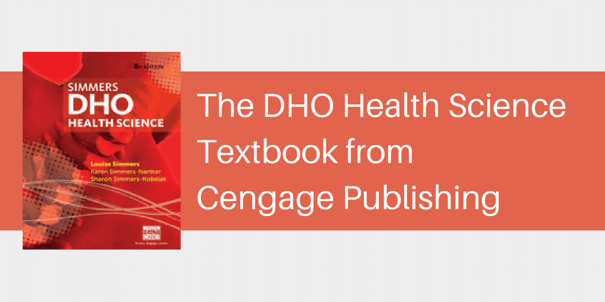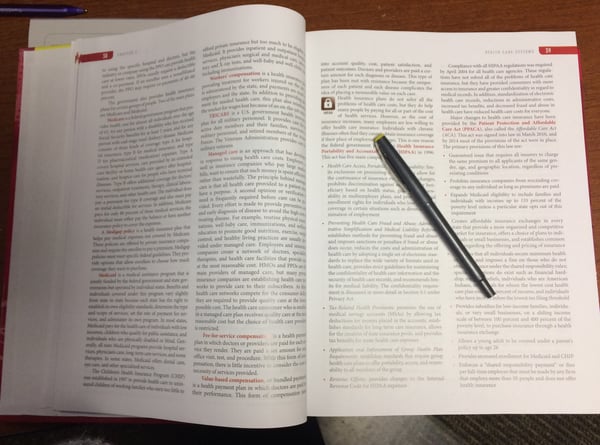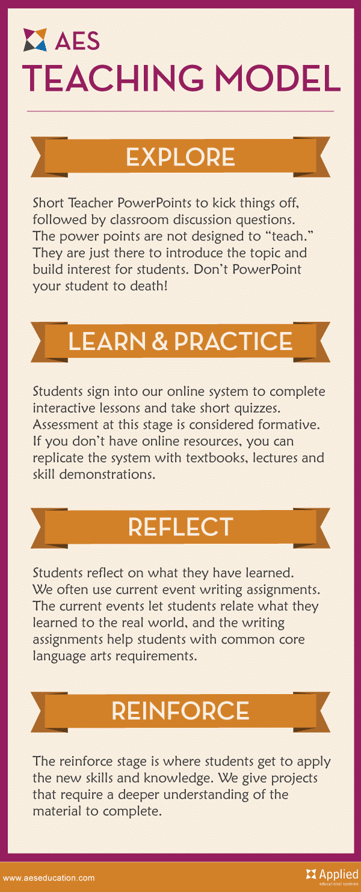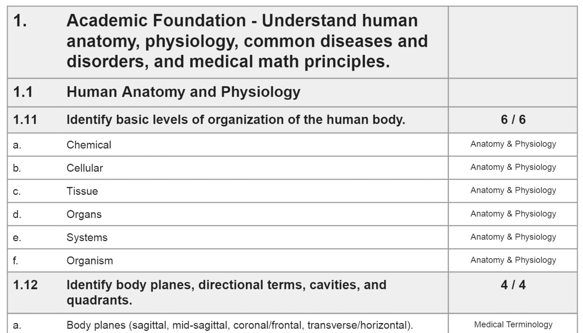Health Science | Textbooks | Diversified Health Occupations
The DHO Health Science Textbook vs. HealthCenter21: Which is Better?
As a health science curriculum provider, we talk to thousands of health science instructors across the United States. When talking to these instructors, many of them are in search of new curriculum, but don’t know what would work best. Very often, these educators ask questions like: “Which curriculum is best? The Cengage DHO Health Science textbook or the HealthCenter21 eLearning curriculum?”
As much as teachers and administrators would like a quick, easy, definitive answer, there’s just no way to reply based on that question alone. In order to answer the question about which is better for your classroom, I have to either A - ask you more questions about your specific classroom or B - answer so thoroughly that it covers most cases.
Since we’re not in the practice of writing articles that help just one person, I’m going to go with B in hopes that I cover just about everyone’s situation. In the article, I will describe how each curriculum option is arranged, and then share the Good and the Bad to help you learn where each is the best fit for health science courses.
What is the DHO Health Science Textbook?

First, let’s take a look at the Diversified Health Occupations textbook, now called DHO Health Science for the updated 8th edition. This text is referred to by many health science instructors as "the big red book."
The Layout of Diversified Health Occupations
The DHO text is well organized and is divided into two parts. The first part of this health science textbook, Basic Health Care Concepts and Skills, begins with health care foundations. The second part, Special Health Care Skills, focuses on skills needed for entry-level positions for many health science career paths. Each chapter has a number of sections, such as:
- Chapter Objectives
- Key Terms
- Today’s Research: Tomorrow’s Health Care
- Career Highlights
- Procedure Sections
- Internet Searches
- Review Questions
Each chapter begins with Chapter Objectives and a list of Key Terms the students will encounter. The Chapter Objectives are a list of skills students should be able to do after completing the chapter. Key Terms are included to highlight important vocabulary students will need to know.
Throughout most chapters, students will find “Today’s Research: Tomorrow’s Health Care” and “Career Highlights.” The Today’s Research: Tomorrow’s Health Care boxed sections point out current research that could lead to health breakthroughs in the future, such as new pharmaceuticals, techniques, and cures. The Career Highlights sections describe health related careers, educational requirements, places of employment, and job descriptions.
Procedure Sections include detailed step-by-step instructions for completing health care procedures.
Internet Searches and Review Questions round out each chapter. The Internet Searches give topics, words, and phrases and suggest keywords for students to search to further their study of topics introduced in the chapter. The Review Questions verify student understanding of the chapter material.
The Good Side of Diversified Health Occupations
The Diversified Health Occupations textbook is rather legendary, and there are many reasons for its legendary status. The greatest is that it has very comprehensive coverage of all things health science. This book is thorough. Very thorough. So while it’s pricey, you are getting a great bang for your buck with this text.
In addition, it's been around for many years and is considered by many CTE educators to be "the authority on careers in health care." DHO is a remarkable reference tool for both students and teachers.
Another benefit is the content of the text is correlated to the National Health Care Foundation Standards. This is very beneficial because adherence to standards is critical for any health science classroom resource.
Along with the DHO Health Science textbook, several supplemental materials are available, including:
- Teacher Resource Kit: includes classroom management activities, lesson plans, assessments, activities, visual aids, and more.
- Instructor’s Manual: includes answers to student workbook and review questions.
- Workbook: includes assignments and evaluations.
- Instructor Companion Website: includes a digital test bank, PowerPoint presentations, images and animations, and more.
- MindTap: this feature is accessible via a web code and includes learning paths, simulations, and content and course flexibility and customization.
- Student Online Companion: includes medical terminology podcasts and anatomy and physiology processes animations.
What are teachers saying about DHO? Our president, Jim Schultz, recently had the opportunity to visit some health science teachers in Florida. Shurene Major, of West Port High School in Marion County said: "I tell you what that book [DHO] is good for: Medical Terminology."
The Bad Side of the DHO Textbook
While no one is arguing that DHO isn’t a significant “go-to” tool for health science teachers, there are some drawbacks worth mentioning.
No matter how great a textbook is, in the volatile world of health science, we all know that learning cannot be achieved by textbook alone. The textbook is a valuable source of reference for students and teachers. But it's flat, slow-to-change, unengaging, and frankly HEAVY...both literally and figuratively.
When Jim Schultz attended the ACTE VISION 2016 Conference, he had the opportunity to see Jessica Young, the 2016 ACTE National New Teacher of the Year, make a presentation. Jim’s take away?
"She made a great presentation. She held up the DHO text, and she said, ‘I use one of these as references. I would never let any of my students touch this book.’ She takes every one of those chapters and she develops a game as part of her instructional strategy."
Why might a health science teacher avoid having students go into DHO on their own? Here’s a sample of a page your students will come across in the book:

That page is going to take some serious dedication to get through. Most pages have images, text boxes, and other things to break up the text, but these text-heavy pages also exist in number. When your students flip to one of these pages, you can imagine the sighs and groans of defeat coming from their souls.
Don’t think I’m being serious? Another teacher that Jim visited in Florida, Hollie Cunningham from West Port High School in Marion County Public Schools, said about DHO:
“The kids pick it up and it's like they fall asleep."
Bored, unengaged students are a teacher’s worst nightmare. Heavy reliance on a massive textbook such as Diversified Health Occupations should give you pause. It’s 2017. You have other options.
Another issue with DHO is that the proof of “standards-based” curriculum is weak. I’m not saying the coverage isn’t there...but the proof of the coverage could be better. There is a one-page chart in the back of the book that houses this “correlation.” The chapter titles are listed on the left and the top of the chart lists general titles of standards such as “Health Care Core Standards” and “Health Informatics.” If that general title is “covered” in the chapter, an X is displayed. The level of detail is lacking and could be an issue depending on what teachers are required to offer as proof of coverage.
Finally, procedures is one other area where "the big red book" misses getting the gold star. The procedures are lengthy and detailed to the point of exhaustion. Sometimes less is more and when it comes to practicing skills, brief, concise directions are best.
What is HealthCenter21?
HealthCenter21 is an interactive eLearning curriculum for health science courses. It includes engaging, interactive online lessons with electronic assessments. Along with the online curriculum, many resources are included for teachers and students.
The Layout of HealthCenter21
HealthCenter21 is a 4-phase curriculum, designed to be used as a resource for teachers in a blended learning environment. The phases are used to provide variety and the best possible way for your students to learn. The phases are:
- Explore
- Learn & Practice
- Reflect
- Reinforce
This graphic explains the AES Teaching Model using each of the phases, or you can read the more in-depth descriptions below:

Phase One: Explore
HealthCenter21 includes PowerPoint presentations (with speaker notes) for each unit within a module. These presentations can be used to introduce the topics that the students will be learning about.
Phase Two: Learn and Practice
In this phase, students use HealthCenter21 to learn about the topics. The multimedia used throughout the lessons enhances the learning by providing narrated content with illustrations, step by step directions for clinical procedures, and videos for communication exercises. The narrated content sets HealthCenter21 apart from the traditional textbook, and assists the less able reader to gain a better understanding of what they need to know.
The content is also interactive, and students are asked inline, formative assessment questions to reinforce their knowledge. Also, automatically graded quizzes and tests are the summative assessments which can be reviewed by the instructor in the grades dashboard.
Phase Three: Reflect
It’s back to the instructor to discuss with the students what they have learned, and maybe introduce a little journal writing to tie into common core standards for English Language Arts. A common activity used for the Reflect phase is a Current Event Report.
Phase Four: Reinforce
Once again, HealthCenter21 provides the instructor with resources (projects, role playing exercises, etc.) to help students gain complete understanding. Experienced instructors will also use their own projects as additional blended learning materials.
The Good Side of HealthCenter21
The most obvious benefit to HealthCenter21 is its vibrant, interactive, and engaging delivery of curriculum. Students can work through the eLearning lessons at their own pace. Each lesson begins with Objectives, includes Check Your Understanding questions throughout, and ends with a Review of important content covered in the lesson.
In addition to the engaging curriculum, HealthCenter21 includes assessments that are graded automatically. After completing a unit, students take quizzes, and at the end of a module, students take tests. Teachers can also create custom assessments with the Create Exam feature.
Another benefit to HealthCenter21 are the skills checklists. Not too long ago, we interviewed a teacher sharing her experience with DHO. One very enlightening comment she made was that she prefers the HealthCenter21 skills checklists for procedures over those provided in the big red book.
Why?
It turns out that the checklists provided in HealthCenter21 were simpler, cleaner, and easier for students to follow and perform successfully than those provided in the DHO Health Science textbook.
HealthCenter21 does a remarkable job with standards-based content and correlations. Standards are broken down to a detailed level to show specifically what content is covered and where. This kind of proof is helpful to teachers and administrators concerned with meeting national and state health science education standards.

Segment of a correlation for HealthCenter21
In addition, HealthCenter21 provides report features for getting the most of your data (data you won’t have with any textbook). For example, you can run a Question Detail Analysis report that will show you how your students performed overall on individual questions. You can also run a report that shows individual student time spent online in the system.
HealthCenter21 also includes hundreds of valuable resources for teachers and students. Students complete worksheets electronically or on paper as they go through the lessons. This helps students pull out the most important information from the lessons and cement that content in their minds. There are lesson plans, classroom activities, and just about anything else you can think of that would be useful to teachers and students.
Perhaps one of the greatest benefits to HealthCenter21 is that it is so fluid. Because the content is delivered online, edits, updates, and new content can be added at any time. For example, in 2015 when The American Heart Association made changes to CPR guidelines, HealthCenter21 updated the CPR Methods module. There’s no need to wait until the next edition goes to press. And because HealthCenter21 is changeable, feedback and suggestions from teachers that are using the curriculum are not only welcomed, they are often implemented.
The Bad Side of HealthCenter21
One drawback to HealthCenter21, or any online curriculum, is that it relies on the Internet and access to other technologies. Sometimes the Internet goes down and sometimes there are technical difficulties, all of which can be very frustrating for teachers and students. Teachers using HealthCenter21 or other eLearning curriculum should always have a back-up plan.
HealthCenter21 or the DHO Textbook... Which is Better?
Which classroom resource is better for your students? The DHO textbook or HealthCenter21? The most honest answer is BOTH! Both the textbook and eLearning curriculum have benefits and drawbacks. Together, they provide the very best tools for teaching health science foundations and shouldn't be mutually exclusive.
Rather, HealthCenter21 and DHO blend beautifully together to provide students with the very best possible health science education. HealthCenter21 provides impactful methods of teaching students by providing engaging, interactive lessons and supporting resources. DHO provides a mighty reference for students and teachers and provides the ease of looking up a term and finding exactly where it’s covered quickly.

